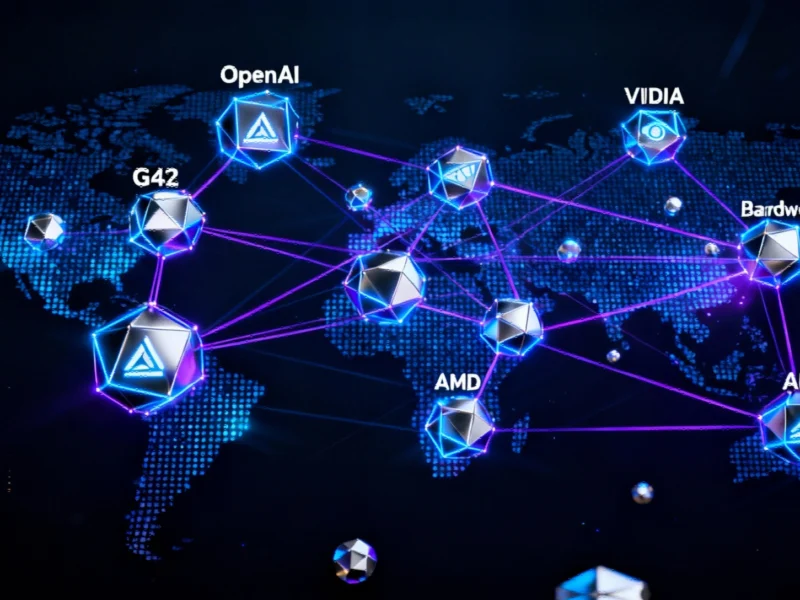Strategic Partnerships Fuel Unprecedented AI Infrastructure Expansion
OpenAI is orchestrating what industry analysts are calling the most ambitious artificial intelligence infrastructure network in history, with recent partnerships and agreements surpassing $1 trillion in combined value. The scale of this expansion was detailed in a comprehensive analysis that reveals how OpenAI is building a trillion-dollar AI infrastructure network through strategic alliances with chip manufacturers, cloud providers, and international partners.
During a recent appearance at GITEX Global 2025 in Dubai, OpenAI CEO Sam Altman and G42’s Peng Xiao discussed the collaborative future of AI development. Peng emphasized the necessity of partnership, stating, “No company and no individual can do this alone, and that’s why we’re here sharing the stage with Sam as an equitable partner.” This philosophy underpins OpenAI’s approach as it builds what industry observers describe as a circular financing model where GPU vendors fund OpenAI, OpenAI drives demand, and vendors profit in return.
Chip Manufacturing Partnerships Reach Unprecedented Scale
OpenAI’s most recent agreement with Broadcom represents one of the largest semiconductor partnerships in history. The collaboration will see OpenAI designing custom chips with Broadcom, with deployment plans calling for processors consuming 10 gigawatts of electricity in the second half of next year alone.
“Partnering with Broadcom is a critical step in building the infrastructure needed to unlock AI’s potential and deliver real benefits for people and businesses,” Altman stated. He emphasized that developing proprietary accelerators contributes to the broader ecosystem of partners collectively building the capacity required to advance AI capabilities.
Broadcom CEO Hock Tan characterized the collaboration as “a pivotal moment in the pursuit of artificial general intelligence,” highlighting the significance of co-developing and deploying next-generation accelerators and network systems. This massive chip initiative comes as new cooling technologies using lasers are emerging to address the thermal challenges of high-performance computing.
Global Infrastructure Projects and Energy Requirements
The centerpiece of OpenAI’s international expansion is Stargate UAE, a $500 billion public-private project developed in partnership with G42. This represents the first international site in OpenAI’s global infrastructure initiative and involves collaboration with the U.S. government, Oracle, and SoftBank.
Additional massive supply agreements include:
Nvidia’s $100 billion deal for tens of thousands of GPUs
Microsoft’s $13 billion Azure partnership extending their longstanding collaboration
AMD’s potential $100 billion role providing 6 gigawatts of next-generation chips
The energy requirements alone are staggering, with the combined infrastructure expected to consume power at a scale comparable to medium-sized countries. This expansion occurs amid growing concerns about AI-powered cyberattacks targeting critical infrastructure and the need for robust security measures.
Supply Chain Integration and Market Implications
OpenAI now manages every layer of the AI supply chain, from chip design and manufacturing to cloud infrastructure and energy procurement. This vertical integration strategy has contributed to the company’s valuation surpassing $500 billion, with its growth closely tied to nearly $3 trillion in expected data center spending through 2028.
The financing model relies heavily on private credit, with approximately $800 billion expected to be funded through this channel. However, industry experts are beginning to question the sustainability of this approach, particularly as major tech companies face economic pressures that could impact their ability to maintain such massive investments.
Global Security and Infrastructure Considerations
As OpenAI expands its international footprint, questions about data sovereignty and security infrastructure have gained prominence. The company’s partnerships with various governments and the scale of its operations necessitate advanced security protocols. This expansion coincides with initiatives like the UK government’s secure computing infrastructure facility and concerns about widespread credential vulnerabilities in government systems.
The financial technology sector is also watching these developments closely, as the UK positions itself as a fintech innovation hub that could leverage OpenAI’s expanding capabilities.
Sustainability Questions Loom Over Massive Expansion
While the technical and financial scale of OpenAI’s infrastructure network is unprecedented, industry observers are raising important questions about long-term viability. The circular financing model, while effective in driving rapid expansion, faces scrutiny regarding its sustainability as investment requirements continue to escalate.
The fundamental question remains: How long can this model last before the money runs thin? As OpenAI pushes the boundaries of what’s possible in artificial intelligence, the world watches to see if this trillion-dollar gamble will pay off in achieving artificial general intelligence or if the financial structure supporting it will require significant recalibration in the coming years.
Based on reporting by {‘uri’: ‘techradar.com’, ‘dataType’: ‘news’, ‘title’: ‘TechRadar’, ‘description’: ”, ‘location’: {‘type’: ‘country’, ‘geoNamesId’: ‘2635167’, ‘label’: {‘eng’: ‘United Kingdom’}, ‘population’: 62348447, ‘lat’: 54.75844, ‘long’: -2.69531, ‘area’: 244820, ‘continent’: ‘Europe’}, ‘locationValidated’: False, ‘ranking’: {‘importanceRank’: 159709, ‘alexaGlobalRank’: 1056, ‘alexaCountryRank’: 619}}. This article aggregates information from publicly available sources. All trademarks and copyrights belong to their respective owners.



